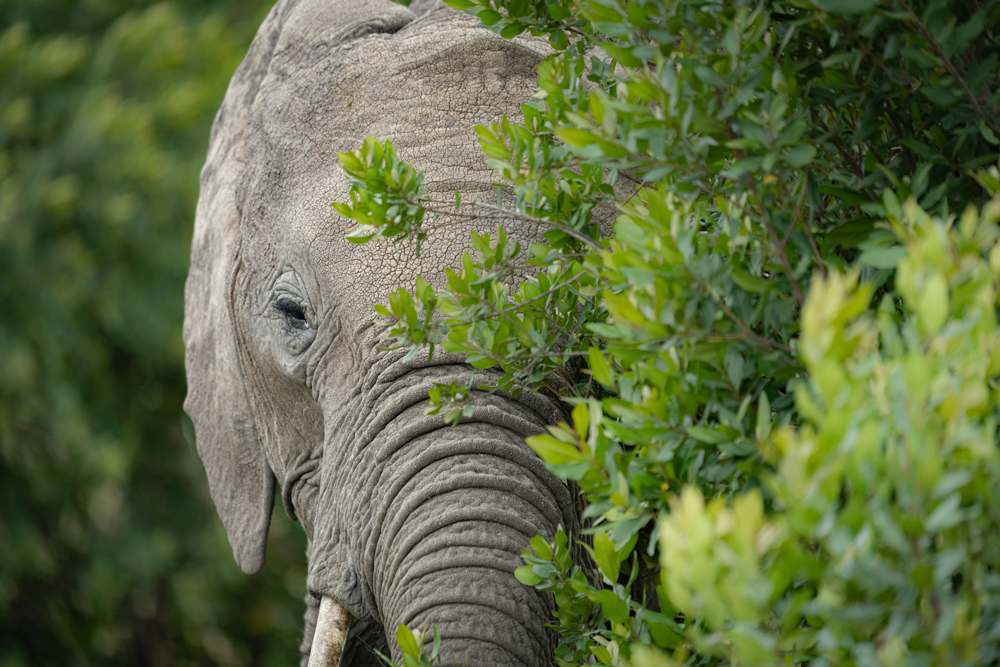African elephants are the largest land animals on earth and significantly larger than their relatives in Asia, from which they are separated by millions of years of evolution.

African elephant in Kenya | Photo: Jan Zwilling, IZW
Nevertheless, Asian elephants have a 20 percent heavier brain, as scientists from Humboldt-Universität zu Berlin and the Leibniz Institute for Zoo and Wildlife Research (Leibniz-IZW) were able to demonstrate together with international colleagues. They also showed that elephant brains triple in weight after birth. These results, published in the scientific journal "PNAS Nexus", provide potential explanations for behavioural differences between African and Asian elephants as well as for the pachyderms' long youth, during which they gain enormous experience and learn social skills.
Elephants are among the best-known and most iconic animal families and are considered to be exceptionally social and intelligent - yet surprisingly little is known about their brains. An international research team led by Malav Shah and Michael Brecht from the Bernstein Center for Computational Neuroscience at Humboldt-Universität zu Berlin (BCCN) and Thomas Hildebrandt from the Leibniz-IZW has now analysed the weight and structure of the brains of Asian elephants (Elephas maximus) and African elephants (Loxodonta africana) based on dissections of wild and zoo animals as well as on literature data and MRI scans.
They showed that externally visible differences - Asian elephants are smaller, have relatively smaller ears, only one "trunk finger" and most of the females have no tusks - and some of the associated behavioural differences extend to the inside of their huge skulls: Adult female Asian elephants have significantly heavier brains, weighing a good 5,300 grams on average, than their African counterparts, which average just over 4,400 grams. This finding could not be conclusively confirmed for male elephants (which have significantly heavier brains in both species) owing to the limited data available on Asian elephants. However, the cerebellum is proportionally heavier in African elephants (a good 22 per cent of the total brain weight) than in Asian elephants (a good 19 per cent).
Elephant brains grow almost as much as human brains after birth
The scientists were also able to show that elephants exhibit very large postnatal brain growth. The brains of adult elephants are about three times as heavy as they were at birth. This means that elephants have a significantly higher lifetime brain growth than all primates - with the exception of humans, in which the brain at birth weighs only around a fifth of its final weight.
The fact that these findings on the size of elephant brains are new is explained by the challenging acquisition of the objects of investigation: Extracting elephant brains from the skulls of deceased animals is a complex and very rarely performed veterinary procedure. For the present study, 19 brains were analyzed that were extracted at the Leibniz-IZW from deceased zoo animals or animals euthanized for animal welfare reasons (14) or obtained from dissections of wild elephants that had died (5), including in Kruger National Park in South Africa. In addition, the scientists were able to include data on six additional brains from an earlier study by another research team in their analysis.
Brain size as a possible explanation for differences in behaviour and motor skills?
"The difference in brain weight is perhaps the most important difference between these two elephant species", says Malav Shah from the BCCN, first author of the paper. "It could explain important behavioural differences between Asian and African elephants." For example, both species show very different behaviour when interacting with humans. Asian elephants have been partially domesticated over thousands of years and are used as work animals in different cultures and regions. In the case of African elephants, there are only very few cases in which domestication was even partially successful. It is much more difficult to habituate African elephants to human company than Asian elephants.
The fact that their brains grow so much over the course of an elephant's life seems plausible to the study heads, Michael Brecht and Thomas Hildebrandt: "Social factors and learning processes could explain the strong brain growth after birth, as elephants live in complex social structures and have an outstanding memory. The experience and accumulated knowledge of adult elephants, especially matriarchs, is central to the group behaviour of elephants and the young animals are very closely cared for over a long period of childhood and adolescence." The fact that the cerebellum is larger in African elephants relative to the animals' overall size could be related to the more complex motor function of the trunk in this species. With their two trunk fingers, African elephants can perform more diverse movements, which is also reflected in a higher number of neurons in the trunk's control centre in the brain.
Brecht and Hildebrandt point to the many unanswered questions in researching the brains of Asian and African elephants and their significance for motor skills and social behaviour. They will continue their intensive research into these fascinating, intelligent animals and their "control centres".
Shah M, Heise O, Buss P, de Klerk-Lorist LM, Hetzer S, Haynes JD, Hildebrandt TB, Brecht M (2025):
Larger Brains and Relatively Smaller Cerebella in Asian Compared to African Savanna Elephants.
PNAS Nexus, Volume 4, Issue 5, May 2025, pgaf141. DOI: 10.1093/pnasnexus/pgaf141






